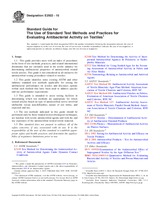Wir benötigen Ihre Einwilligung zur Verwendung der einzelnen Daten, damit Sie unter anderem Informationen zu Ihren Interessen einsehen können. Klicken Sie auf "OK", um Ihre Zustimmung zu erteilen.
ASTM E2922-15
Standard Guide for The Use of Standard Test Methods and Practices for Evaluating Antibacterial Activity on Textiles
Automatische name übersetzung:
Standard-Leitfaden für den Einsatz von Standard-Test- Methoden und Verfahren zur Bewertung der antibakteriellen Aktivität auf Textilien
NORM herausgegeben am 1.5.2015
Informationen über die Norm:
Bezeichnung normen: ASTM E2922-15
Anmerkung: UNGÜLTIG
Ausgabedatum normen: 1.5.2015
SKU: NS-609283
Zahl der Seiten: 5
Gewicht ca.: 15 g (0.03 Pfund)
Land: Amerikanische technische Norm
Kategorie: Technische Normen ASTM
Kategorie - ähnliche Normen:
Die Annotation des Normtextes ASTM E2922-15 :
Keywords:
antimicrobial, antibacterial, neutralizer, inoculum bioload, leaching, migrating, immobilized, cross-linked, non-leaching, textiles and textile surfaces,, ICS Number Code 59.080.01 (Textiles in general)
Ergänzende Informationen
| Significance and Use | ||||||||||||||||||||||
|
4.1 Antimicrobial agents are routinely used for treating textile materials for the reduction of biodeterioration and bacterial odor generation. Furthermore, textiles are treated to prevent or limit microbial cross-contamination in healthcare settings. 4.2 Antimicrobial agents used in textiles will vary with regard to their broad-spectrum effectiveness, biostatic/biocidal properties, and binding properties in or on particular substrates. When selecting antibacterial test methods as the sole means to predict end use behavior it is critical to understand the intended end use conditions of the treated articles. 4.3 Textile materials differ with regard to the knit/weave, fabric composition, and added functional feature (for example, water repellent, flame retardant, softener, whitener). Each of these factors may alter test results within a given method. 4.4 The test methods indicated below differ mainly in the procedure for inoculating samples, levels of nutrients in the bacterial challenge, organisms used, and exposure times. 4.5 This guide is intended to review each commonly used industry standard test method for its applicability with an understanding of each of the factors listed above. Further, it is the intention of this guide to indicate commonly used and generally accepted modifications of each method when measuring specific end-use functionalities. 4.6 These test methods are not, in themselves, absolute indicators of real life performance. Such performance criteria are developed based on a series of antimicrobial and analytical test methods in addition to simulated real life use studies. All antimicrobial agents used for the treatment of textiles should be compliant with local regulatory agencies and should be deemed safe for the proposed end-use and claims. |
||||||||||||||||||||||
| 1. Scope | ||||||||||||||||||||||
|
1.1 This guide provides users with an index of procedures in the form of test methods, practices, and related international documents that are currently used in the textile industry for determining antibacterial properties of antimicrobial treated textile articles. This guide is not considered as all-inclusive for antimicrobial testing procedures related to textiles. 1.2 This guide identifies some existing ASTM and other industry standard test methods applicable for testing the antibacterial performance on textiles and discusses options within each method that have been used to address specific end-use performance expectations. 1.3 This guide is intended to assist testing facilities in determining which test methods are appropriate for which treated articles based on type of antimicrobial active involved (diffusible versus non-diffusible), nature of test fabric, and expected end use. 1.4 The test methods indicated in this guide should be performed only by those trained in microbiological techniques, are familiar with textile antimicrobial agents and with the end use exposures of the antimicrobial treated textile material. 1.5 This standard does not purport to address all of the safety concerns, if any, associated with its use. It is the responsibility of the user of this standard to establish appropriate safety and health practices and determine the applicability of regulatory limitations prior to use. |
||||||||||||||||||||||
| 2. Referenced Documents | ||||||||||||||||||||||
|
Empfehlungen:
Aktualisierung der technischen Normen
Wollen Sie sich sicher sein, dass Sie nur die gültigen technischen Normen verwenden?
Wir bieten Ihnen eine Lösung, die Ihnen eine Monatsübersicht über die Aktualität der von Ihnen angewandten Normen sicher stellt.
Brauchen Sie mehr Informationen? Sehen Sie sich diese Seite an.




 Cookies
Cookies
